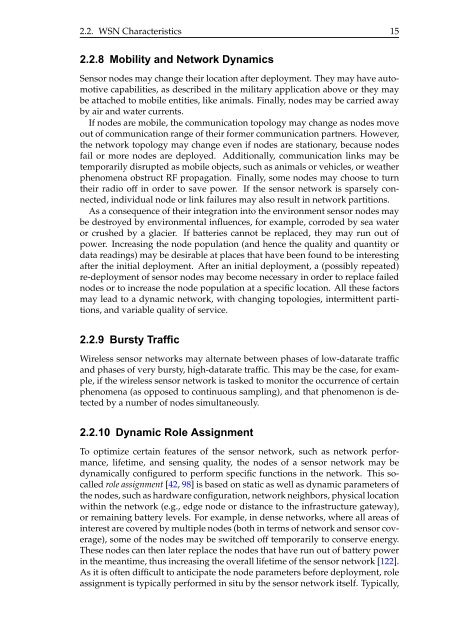A State-Based Programming Model for Wireless Sensor Networks
A State-Based Programming Model for Wireless Sensor Networks
A State-Based Programming Model for Wireless Sensor Networks
You also want an ePaper? Increase the reach of your titles
YUMPU automatically turns print PDFs into web optimized ePapers that Google loves.
2.2. WSN Characteristics 15<br />
2.2.8 Mobility and Network Dynamics<br />
<strong>Sensor</strong> nodes may change their location after deployment. They may have automotive<br />
capabilities, as described in the military application above or they may<br />
be attached to mobile entities, like animals. Finally, nodes may be carried away<br />
by air and water currents.<br />
If nodes are mobile, the communication topology may change as nodes move<br />
out of communication range of their <strong>for</strong>mer communication partners. However,<br />
the network topology may change even if nodes are stationary, because nodes<br />
fail or more nodes are deployed. Additionally, communication links may be<br />
temporarily disrupted as mobile objects, such as animals or vehicles, or weather<br />
phenomena obstruct RF propagation. Finally, some nodes may choose to turn<br />
their radio off in order to save power. If the sensor network is sparsely connected,<br />
individual node or link failures may also result in network partitions.<br />
As a consequence of their integration into the environment sensor nodes may<br />
be destroyed by environmental influences, <strong>for</strong> example, corroded by sea water<br />
or crushed by a glacier. If batteries cannot be replaced, they may run out of<br />
power. Increasing the node population (and hence the quality and quantity or<br />
data readings) may be desirable at places that have been found to be interesting<br />
after the initial deployment. After an initial deployment, a (possibly repeated)<br />
re-deployment of sensor nodes may become necessary in order to replace failed<br />
nodes or to increase the node population at a specific location. All these factors<br />
may lead to a dynamic network, with changing topologies, intermittent partitions,<br />
and variable quality of service.<br />
2.2.9 Bursty Traffic<br />
<strong>Wireless</strong> sensor networks may alternate between phases of low-datarate traffic<br />
and phases of very bursty, high-datarate traffic. This may be the case, <strong>for</strong> example,<br />
if the wireless sensor network is tasked to monitor the occurrence of certain<br />
phenomena (as opposed to continuous sampling), and that phenomenon is detected<br />
by a number of nodes simultaneously.<br />
2.2.10 Dynamic Role Assignment<br />
To optimize certain features of the sensor network, such as network per<strong>for</strong>mance,<br />
lifetime, and sensing quality, the nodes of a sensor network may be<br />
dynamically configured to per<strong>for</strong>m specific functions in the network. This socalled<br />
role assignment [42, 98] is based on static as well as dynamic parameters of<br />
the nodes, such as hardware configuration, network neighbors, physical location<br />
within the network (e.g., edge node or distance to the infrastructure gateway),<br />
or remaining battery levels. For example, in dense networks, where all areas of<br />
interest are covered by multiple nodes (both in terms of network and sensor coverage),<br />
some of the nodes may be switched off temporarily to conserve energy.<br />
These nodes can then later replace the nodes that have run out of battery power<br />
in the meantime, thus increasing the overall lifetime of the sensor network [122].<br />
As it is often difficult to anticipate the node parameters be<strong>for</strong>e deployment, role<br />
assignment is typically per<strong>for</strong>med in situ by the sensor network itself. Typically,
















